Physical Address
304 North Cardinal St.
Dorchester Center, MA 02124
Physical Address
304 North Cardinal St.
Dorchester Center, MA 02124
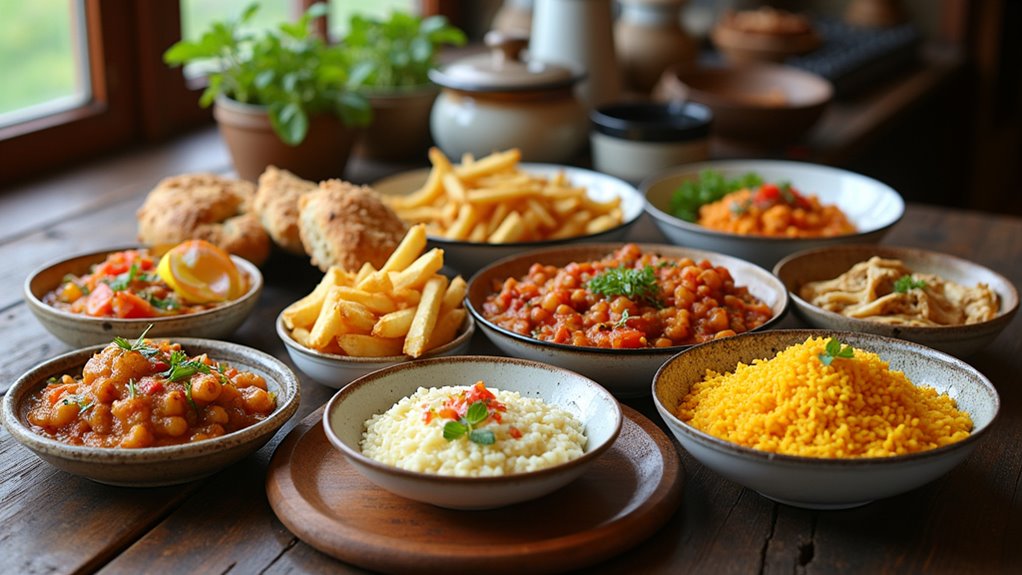
Magnificent European dishes await your taste buds, from authentic pizza to aromatic meatballs, but which one will become your favorite?
Europe’s culinary landscape offers incredible diversity, from Italy’s authentic Neapolitan pizza to Greece’s layered moussaka. You’ll find Spain’s saffron-infused paella, Poland’s comforting pierogi dumplings, and Hungary’s paprika-rich goulash stew. Don’t miss France’s wine-braised coq au vin, Austria’s flaky apple strudel, Balkan grilled cevapi, or Sweden’s aromatic meatballs with lingonberry jam. These nine dishes showcase centuries of tradition, unique preparation techniques, and cultural significance that define European food identity.
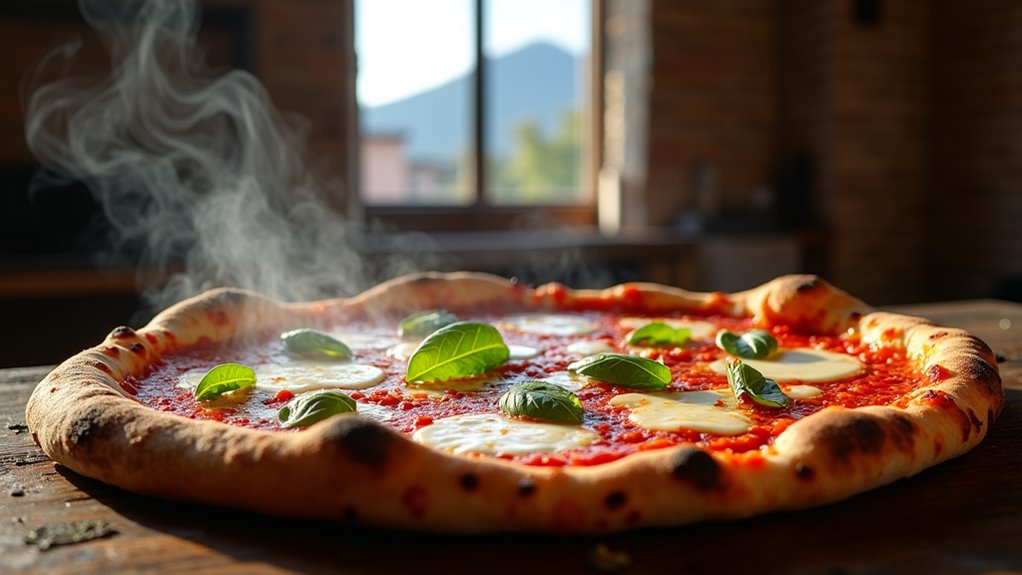
When you bite into an authentic Neapolitan pizza, you’re tasting a slice of history that dates back to 19th century Italy. Created in Naples in 1889 by Raffaele Esposito, this culinary masterpiece has earned UNESCO recognition as an intangible cultural heritage.
The magic lies in simplicity: a hand-kneaded dough of “00” flour, water, salt, and minimal yeast, left to rise slowly for complex flavor development. Topped with San Marzano tomatoes, fresh mozzarella, and basil, then fired in blazing wood ovens for just minutes, it achieves that perfect charred crust. Traditional Neapolitan pizza requires precise temperature control with pizzas typically cooking in just 90 seconds at around 400°C.
While modern variations exist worldwide, Naples remains the pizza pilgrimage destination for foodies seeking authenticity. After enjoying Naples’ culinary treasures, many travelers continue their journey to explore Croatia’s hedonistic nightlife along the Adriatic coast. This humble dish has transcended its origins to become a global phenomenon that unites food lovers everywhere.
Among the jewels of Mediterranean cuisine, Greek moussaka functions as a testament to the art of layering flavors. You’ll find this hearty dish built upon slices of eggplant, topped with a richly spiced meat sauce of lamb or beef, and crowned with creamy béchamel.
The secret lies in proper eggplant preparation—whether fried, grilled, or baked—and a meat sauce enhanced with onions, garlic, cinnamon, and red wine. Many modern cooks prefer the healthier option of grilling or baking eggplant slices rather than the traditional frying method, which can make them oily.
The béchamel, made from butter, flour, and milk, gets its distinctive character from nutmeg, eggs, and cheeses like Parmesan or Kefalotiri. This warming dish is especially comforting in European winters, when temperatures in some northern towns can plummet well below freezing.
Beyond Greek households, moussaka has gained international acclaim while maintaining its status as a symbol of Greek hospitality. When served hot as a main course, you’re experiencing centuries of culinary tradition in each savory bite.
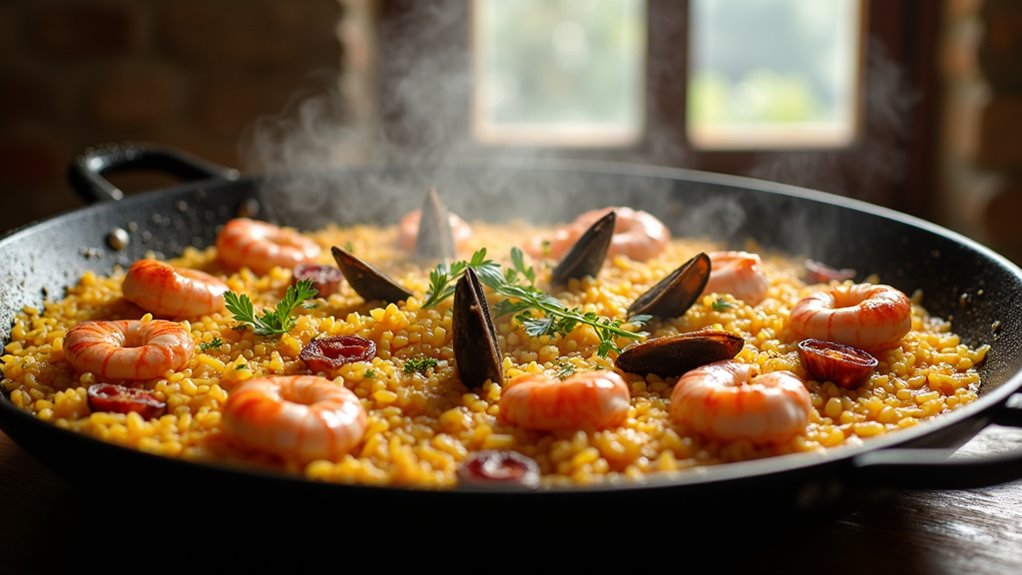
From the mountains of Greece, we travel west to the sun-drenched coasts of Spain, where another iconic Mediterranean dish awaits. Paella, with its vibrant golden hue from precious saffron threads, represents the heart of Spanish cuisine.
Journey westward from Greece to Spain’s sunny shores, where golden saffron-infused paella captures Mediterranean culinary magic.
You’ll find several authentic variations of this beloved dish:
The magic happens in the wide, shallow paella pan where sofrito creates the flavorful base. As you cook, the rice gradually absorbs the seasoned broth, developing that coveted crispy bottom layer called “socarrat.”
It’s this textural contrast that elevates paella from simple rice dish to culinary masterpiece.
Enjoyed outdoors with family and friends, paella embodies Spain’s communal dining tradition and regional pride. Many luxury holiday destinations in Europe celebrate this iconic Spanish dish with gourmet interpretations at high-end restaurants. While traditionally made in a dedicated pan, home cooks can still achieve delicious results using a large skillet instead.
The humble pierogi functions as Poland’s beloved culinary treasure, offering comfort in each pillowy pocket of dough. Dating back centuries, these wheat-based dumplings gained prominence through Saint Hyacinth’s efforts in 13th-century Kraków.
You’ll find pierogi in countless variations across Poland. Traditional fillings range from savory potato-cheese “ruskie” to sweet berry versions, each boiled to perfection and often pan-fried for a crispy finish. They’re typically served with melted butter, fried onions, or sour cream.
Polish emigrants carried their pierogi tradition to North America, particularly industrial cities like Pittsburgh. While similar to Ukrainian varenyky and Russian pelmeni, pierogi maintain a distinct identity in Polish cuisine.
They’re especially treasured during holidays, when families gather to prepare these dumplings that truly warm both body and soul. Specialized cafes known as pierogarnie in Poland showcase the dish’s cultural significance and provide locals and travelers alike with authentic pierogi experiences. Considered an essential component of Polish food classics, pierogi represent the heart of a culinary tradition that continues to delight foodies worldwide.
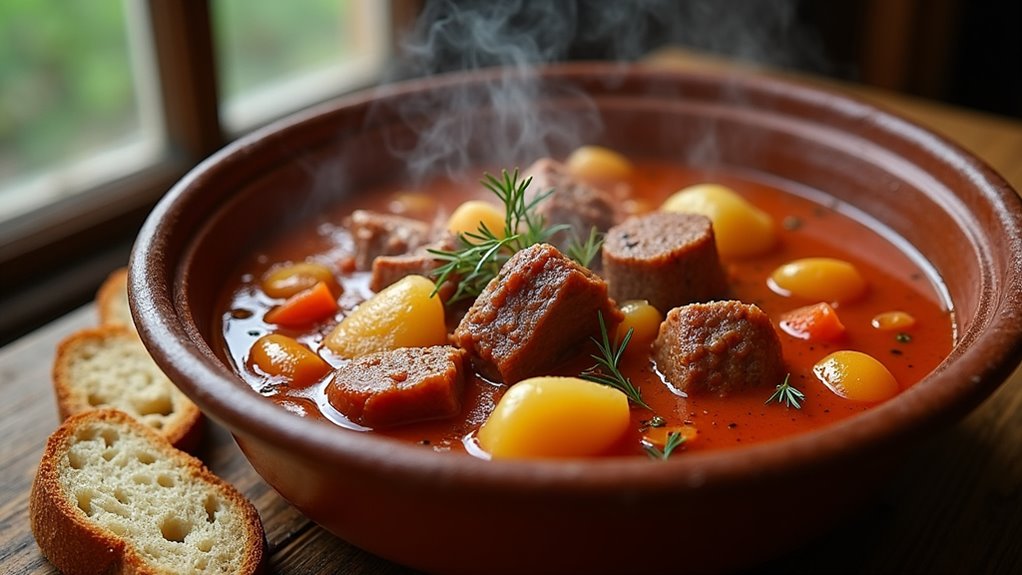
Hungarian goulash functions as the quintessential Central European stew, characterized by its sumptuous paprika-infused broth and tender beef chunks that tell stories of Magyar heritage. This UNESCO-recognized dish originated in the 9th century among cattle herders cooking over open fires. Later, it evolved into a national symbol of Hungarian identity.
In ancient times, this hearty dish was dried in sheep stomachs and later rehydrated with water for consumption by traveling shepherds.
Regional variations abound—from Szeged’s sauerkraut version to the outdoor-cooked bográcsgulyás in traditional cauldrons.
Beloved throughout France for its homey comfort, coq au vin transforms humble ingredients into a masterpiece of rustic elegance through the alchemy of slow cooking. You’ll find this peasant dish dating back centuries, with Julia Child later introducing it to international audiences.
The magic happens when chicken (typically legs and thighs) marries with red wine (traditionally Burgundy or Pinot Noir), bacon, mushrooms, and pearl onions. You’ll want to marinate everything for several hours before slowly braising the chicken until tender. The dish is quintessentially French cuisine, comparable in cultural significance to how Americans view hamburgers. While enjoying this classic dish in France, consider extending your European culinary adventure to include Zagreb’s food scene, which offers its own unique gastronomic treasures.
The sauce thickens beautifully with beurre manié, creating a silky finish.
Serve your coq au vin with crusty bread or boiled potatoes to soak up the sumptuous, wine-infused sauce, and don’t forget a sprinkle of fresh parsley!
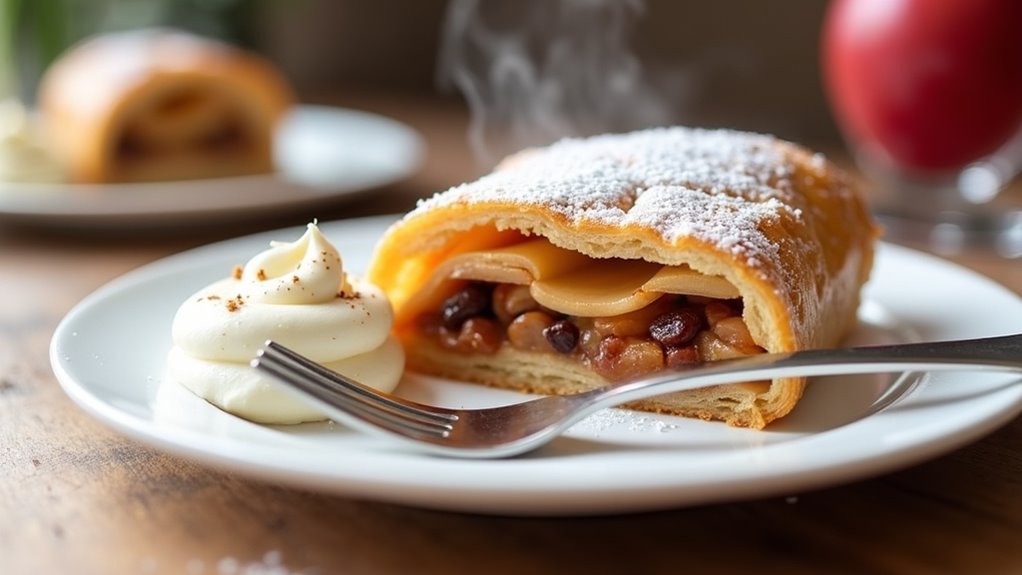
Stretching back centuries to the Habsburg Empire, Austrian apple strudel functions as Vienna’s quintessential dessert achievement—a perfect marriage of paper-thin pastry and spiced apple filling. You’ll find this national treasure in coffeehouses throughout Austria, where the art of hand-stretching dough until it’s translucent remains a celebrated skill passed through generations. The dough becomes so thin that reading through it becomes possible—the mark of master strudel makers. While many European countries have developed their own culinary specialties, Austria’s strudel shares the continent’s rich tradition of iconic dishes worth savoring.
While modern shortcuts exist, nothing compares to authentic strudel rolled by hand—a technique that’s become a tourist draw and culinary education staple.
From Austria’s sweet confections, we move to the savory heart of the Balkans. Cevapi—those finger-sized, caseless sausages—have become the region’s culinary ambassador, especially in Bosnia, Serbia, and Croatia.
You’ll find these grilled meat treasures made from a blend of beef, lamb, and sometimes pork, seasoned with garlic and paprika. Their secret? A 24-hour rest and the addition of baking soda and sparkling water for that perfect texture.
Whether charcoal-grilled traditionally or oven-baked at home, cevapi are best enjoyed tucked into warm lepinja bread with raw onions and kajmak (clotted cream). Many variations exist across the Balkans, including Bulgaria’s kebapche which often incorporates unique cumin flavors.
In coastal regions like Dubrovnik, locals often enjoy cevapi after a day of snorkeling adventures at nearby beaches.
Pair your meal with local beer or rakija for an authentic experience. Don’t forget ajvar, the roasted red pepper relish that perfectly complements these Balkan delights!
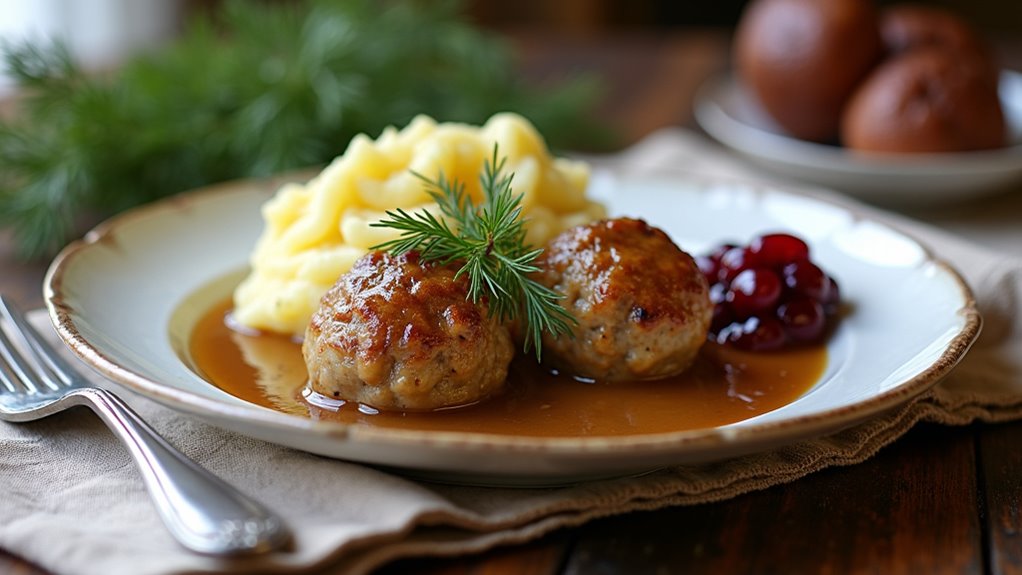
The humble Swedish meatball functions as Northern Europe’s ultimate comfort food, blending simple ingredients with elegant spicing. Dating back to the 18th century, these delightful morsels have conquered the world partly thanks to IKEA, which serves roughly a billion meatballs annually.
You’ll find these national treasures featured prominently at Swedish celebrations like Christmas and Midsummer, representing the quintessential Nordic approach to balanced, comforting cuisine. The dish is best prepared by first browning the meatballs evenly in butter, then baking them covered in chicken broth until they become perfectly tender. Swedish meatballs are considered one of the classic dishes that truly represent authentic Swedish food culture.
Europe’s culinary tapestry is yours to explore! You’ve just glimpsed nine iconic dishes that define continental cuisine, but there’s so much more waiting. Did you know that Europeans spend an average of 2 hours daily on meals—nearly twice the American average? It’s this dedication to mealtime that’s preserved these incredible food traditions. Pack your appetite and plunge into Europe’s delicious heritage whenever you get the chance!